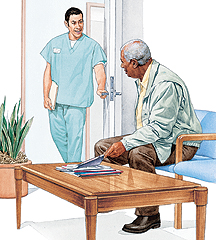Discharge Instructions for Carotid Artery Stenting
Discharge Instructions for Carotid Artery Stenting
When you get home after your procedure, do the following:
Watch the injection site for bleeding. A small bruise is normal as is an occasional drop of blood at the site.
Monitor the limb that was used for changes in temperature, color, numbness, tingling, or loss of function.
Take your prescribed antiplatelet medicines as directed. These medicines will help prevent blood clots from forming on the stent. However, they may cause you to bruise more easily.
Shower instead of taking tub baths for a few days. But, wait for your doctor’s OK to get the wound wet first.
Avoid lifting anything over 10 pounds for a few days.
Take it easy, but try to get back to your normal routine as much as possible.
Ask your doctor about driving, returning to work, and other activities.
When to call your healthcare provider
Call your healthcare provider right away if you have any of these:
Problems at the incision site, such as swelling, redness, bleeding, warmth, leaking of fluids, or increasing pain
A cold or painful leg or foot
Severe headache
Weakness or numbness in a leg or arm
Trouble talking, or finding the words to say what you want
Changes in your vision
Dizziness or imbalance
Go to the emergency room if your doctor’s office is closed.
Your follow-up
Within a month after the procedure, you’ll have a follow-up exam and tests. These tests may include an ultrasound and a brain function exam. Then you’ll be monitored with ultrasound or another imaging test every 6 months for 1 to 2 years. After that, you’ll be monitored at least every 12 months. You may also continue to take antiplatelet medicine. In some cases, the carotid artery can narrow again. If this happens, it can often be treated again with balloon angioplasty.
Call 911
Call 911 if you have any of these stroke symptoms:
Paralysis or weakness on one side of the body
Numbness or tingling on one side of the body
Trouble speaking
Loss of vision in one eye
Drooping on one side of the face
Dizziness or imbalance
Swelling or persistent pain in the groin
Updated:
September 04, 2017
Sources:
Carotid Artery Stenting and its Complications, UpToDate, Guideline on the Management of Patients With Extracranial Carotid and Vertebral Artery Disease. Brott, T. Circulation. 2011. is. 124. ed. 4, pp. s54-130.
Reviewed By:
Fetterman, Anne, RN, BSN,Sudheendra, Deepak, MD
